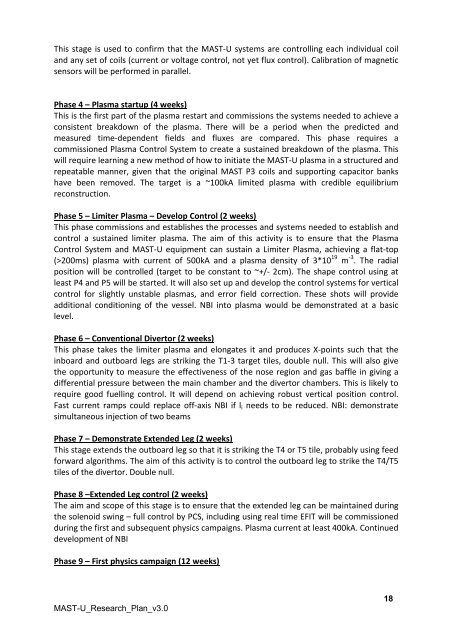MAST-U_RP_v3
MAST-U_RP_v3
MAST-U_RP_v3
You also want an ePaper? Increase the reach of your titles
YUMPU automatically turns print PDFs into web optimized ePapers that Google loves.
This stage is used to confirm that the <strong>MAST</strong>-U systems are controlling each individual coiland any set of coils (current or voltage control, not yet flux control). Calibration of magneticsensors will be performed in parallel.Phase 4 – Plasma startup (4 weeks)This is the first part of the plasma restart and commissions the systems needed to achieve aconsistent breakdown of the plasma. There will be a period when the predicted andmeasured time-dependent fields and fluxes are compared. This phase requires acommissioned Plasma Control System to create a sustained breakdown of the plasma. Thiswill require learning a new method of how to initiate the <strong>MAST</strong>-U plasma in a structured andrepeatable manner, given that the original <strong>MAST</strong> P3 coils and supporting capacitor bankshave been removed. The target is a ~100kA limited plasma with credible equilibriumreconstruction.Phase 5 – Limiter Plasma – Develop Control (2 weeks)This phase commissions and establishes the processes and systems needed to establish andcontrol a sustained limiter plasma. The aim of this activity is to ensure that the PlasmaControl System and <strong>MAST</strong>-U equipment can sustain a Limiter Plasma, achieving a flat-top(>200ms) plasma with current of 500kA and a plasma density of 3*10 19 m -3 . The radialposition will be controlled (target to be constant to ~+/- 2cm). The shape control using atleast P4 and P5 will be started. It will also set up and develop the control systems for verticalcontrol for slightly unstable plasmas, and error field correction. These shots will provideadditional conditioning of the vessel. NBI into plasma would be demonstrated at a basiclevel.Phase 6 – Conventional Divertor (2 weeks)This phase takes the limiter plasma and elongates it and produces X-points such that theinboard and outboard legs are striking the T1-3 target tiles, double null. This will also givethe opportunity to measure the effectiveness of the nose region and gas baffle in giving adifferential pressure between the main chamber and the divertor chambers. This is likely torequire good fuelling control. It will depend on achieving robust vertical position control.Fast current ramps could replace off-axis NBI if l i needs to be reduced. NBI: demonstratesimultaneous injection of two beamsPhase 7 – Demonstrate Extended Leg (2 weeks)This stage extends the outboard leg so that it is striking the T4 or T5 tile, probably using feedforward algorithms. The aim of this activity is to control the outboard leg to strike the T4/T5tiles of the divertor. Double null.Phase 8 –Extended Leg control (2 weeks)The aim and scope of this stage is to ensure that the extended leg can be maintained duringthe solenoid swing – full control by PCS, including using real time EFIT will be commissionedduring the first and subsequent physics campaigns. Plasma current at least 400kA. Continueddevelopment of NBIPhase 9 – First physics campaign (12 weeks)<strong>MAST</strong>-U_Research_Plan_<strong>v3</strong>.018


